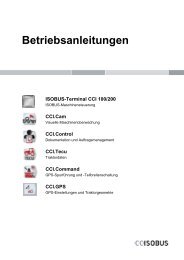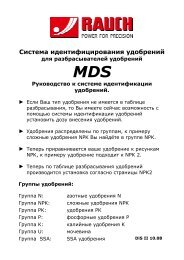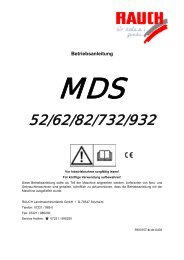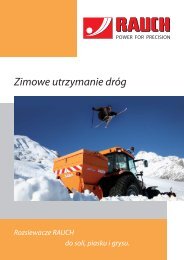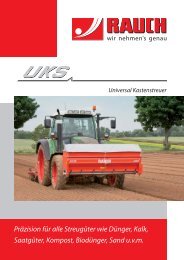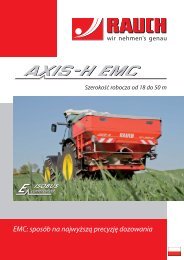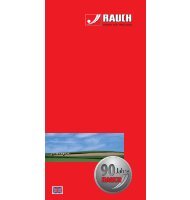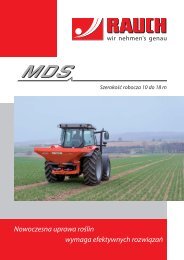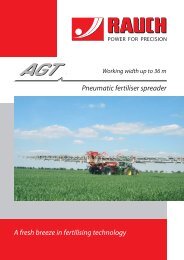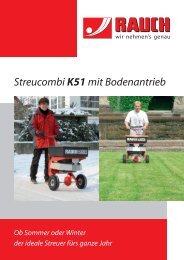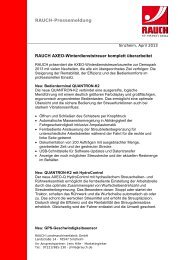DLZ Endurance test - Rauch
DLZ Endurance test - Rauch
DLZ Endurance test - Rauch
You also want an ePaper? Increase the reach of your titles
YUMPU automatically turns print PDFs into web optimized ePapers that Google loves.
Practice • Future • Life<br />
Special edition<br />
from brochure 1/2013 I PO box 40 05 80 I 80705 Munich<br />
Tel. +49(0)89-12705-276 I reddlz@dlv.de I www.dlz-agrarmagazin.de<br />
<strong>Endurance</strong> <strong>test</strong>: AXIS-H EMC+W<br />
Spreading<br />
to the point<br />
Distributed by:<br />
RAUCH Landmaschinenfabrik GmbH<br />
D-76547 Sinzheim; PO box 1162<br />
Phone +49 (0) 7221/9850<br />
Fax +49 (0) 7221/985200<br />
info@rauch.de; www.rauch.de
dlz Technology<br />
Spreading<br />
to the point<br />
<strong>Endurance</strong> <strong>test</strong> The Axis-H-EMC is a hydraulically powered fertiliser<br />
spreader with a working width of 18 to 50 m. The application rate is regulated<br />
electronically by the mass flow; additionally, a pair of scales control the<br />
residual quantity. Here is our verdict after one season.<br />
Photo: Feuerborn<br />
dlz agricultural magazine ◾ Special edition
dlz Technology I <br />
Weighing spreaders are<br />
very much in fashion.<br />
They allow you to control<br />
the amount of fertiliser precisely<br />
and make unwanted excess<br />
or insufficient quantities a thing<br />
of the past. The operator also doesn‘t have<br />
to worry about turning it off; thanks to a<br />
computer and sensor, the spreader always<br />
applies the desired amount of fertiliser.<br />
What‘s more, variable flow behaviour no<br />
longer leads to wrong fertilisations. While<br />
other manufacturers control the application<br />
rate with the help of a weighing frame, and<br />
so can only regulate the application rate of<br />
the entire spreader, <strong>Rauch</strong> can individually<br />
regulate the spreading amount at each<br />
dlz<strong>test</strong><br />
metering slider. This increases the<br />
precision. This is made possible by<br />
the EMC technology. We <strong>test</strong>ed<br />
an Axis-H 30.1 EMC+W with a<br />
3,000 l. container, a Müller terminal<br />
with a partial width controller<br />
and automatic activation OptiPoint.<br />
"Weighing" with pressure<br />
sensors<br />
For determining the spreading amount by<br />
means of the mass flow principle, <strong>Rauch</strong><br />
uses a simple principle: the higher the torque<br />
is at the spreading disc, the bigger in turn<br />
the application rate will be, and so the bigger<br />
the pressure in the hydraulic system will<br />
be. With the help of oil pressure measure-<br />
Quick overview<br />
What's special about the Axis H-EMC+W<br />
is how it determines the application<br />
rate with the help of the mass flow principle.<br />
With this, you can take advantage of the linear<br />
correlation between the oil pressure in the<br />
hydraulic motors of the spreading disc and<br />
the fertiliser flow rate to the metering sliders.<br />
The application rate can be controlled and<br />
adjusted individually for each side without<br />
the need for large weighing technology. The<br />
scales in the spreader serve only to determine<br />
the contents of the container. In the <strong>test</strong>, the<br />
spreader demonstrated a good spreading<br />
pattern and accurate application.<br />
<strong>Rauch</strong> Axis H-EMC+W<br />
Minimum use (MU): 590 ha/year<br />
MU =<br />
FC<br />
€ 2,537<br />
=<br />
LR–VC € 4.50 – € 0.20<br />
FC<br />
Fixed costs/year: € 2,537<br />
(= 10 % of the cost price € 25,367)<br />
VC<br />
LR<br />
Variable costs/ha: € 0.20<br />
(wear, maintenance)<br />
Loan rate € 4.50/ha.<br />
(without a tractor, driver and diesel)<br />
Sample calculation with sample values 2013<br />
ments, the application rate can be determined<br />
with great precision. The trick to it: if<br />
more fertiliser enters the spreading discs, the<br />
pressure in the hydraulics increases. Pressure<br />
and changes to the spreading amount<br />
follow a linear correlation. The higher the<br />
pressure, the bigger the spreading amount<br />
applied, and vice versa. The problem with<br />
it: The pressure changes in the system are<br />
very small and it must be measured very<br />
sensitively. The development from the initial<br />
concept to being ready for practical use<br />
therefore took some time. The advantage<br />
of this system is its imperviousness from<br />
impacts and bumps, which always influence<br />
the weighing process. Weighing spreaders<br />
with weigh cells must therefore filter the<br />
measurements and separate the accurate<br />
readings from the inaccurate ones. This is<br />
not necessary with the mass flow system<br />
from <strong>Rauch</strong>. The system is also very easy to<br />
set up. There just needs to be a pressure sensor<br />
in the hydraulic line to the motor for the<br />
spreading discs. However, the EMC system<br />
cannot determine the residual quantity or<br />
the tank capacity. <strong>Rauch</strong> has therefore also<br />
used a weighing frame with two weigh cells<br />
– a request made by many practitioners.<br />
Even though the application rates with the<br />
EMC system correspond very closely to the<br />
control measurements, the weighing technology<br />
offers the benefit of precise control<br />
of the residual quantity. And therefore the<br />
area that it is still possible to spread can<br />
easily be determined.<br />
Simple environmentally<br />
optimised boundary spreading<br />
But the hydraulic drive offers even more<br />
advantages: The spreading range of the<br />
spreaders can be adjusted via the remote<br />
With the Axis H-EMC, the electronics take over<br />
the switching on and off at headlands and the<br />
eight-piece partial width controller.<br />
www.dlz-agrarmagazin.de
Technology I <br />
1 2 3<br />
Photos: Feuerborn<br />
1 The spreader is suspended in a weighing<br />
frame with two weigh cells. It is in this way<br />
that the Axis controls the contents of the<br />
container and the residual quantity.<br />
2 Every spreading disc is powered on an<br />
infinitely variable basis by a hydraulics<br />
motor. A sensor measures the pressure to<br />
determine the spread rate.<br />
3 Hydraulic block instead of universal<br />
shafts: We powered the Axis with the load<br />
sensing hydraulics with the control line<br />
from the tractor.<br />
Photos: Feuerborn<br />
4<br />
5<br />
6<br />
controlled spreading disc speed and the<br />
drop point. As such, with the help of GPS<br />
positioning, automatic partial width control<br />
of the fertiliser spreader is possible, and<br />
works independently for the left and right<br />
thanks to two hydraulic drives. The option<br />
of changing the speed of the spreading discs<br />
while simultaneously adjusting the drop<br />
point means environmentally optimised<br />
boundary spreading can also be conducted<br />
easily without a fertiliser stream or other<br />
resources. Double-sided environmentally<br />
optimised boundary spreading is thus also<br />
possible – a practical solution which we<br />
have valued greatly on narrow fields.<br />
Switches on and off<br />
automatically<br />
When do you switch the fertiliser spreader<br />
on or off at the headland? Research has<br />
shown that it's being switched on too early.<br />
The fertiliser thrown behind flies further<br />
behind than you might think. If switched<br />
on early, it is thrown on the already fertilised<br />
headland, leading to over-fertilisation.<br />
It's a different story at the end of<br />
the field: Here, if the slider is closed too<br />
4 The drop point and disc opening<br />
(application rate) are controlled automatically<br />
from the terminal by actuators.<br />
5 The spreading discs can be replaced<br />
very easily, whether that's for switching off,<br />
emptying or changing to a different<br />
spreading range. The spreading blades<br />
are made from wear-resistant steel.<br />
6 The agitator fingers are very gentle on<br />
the fertiliser. The large opening enables the<br />
drop point to be adjusted for changes to the<br />
amount or for environmentally optimised<br />
boundary spreading.<br />
early, it will lead to under-fertilisation. But<br />
when is it the right switching on point?<br />
The technicians from <strong>Rauch</strong> have ensured<br />
that the switch point depends heavily on<br />
Technical data<br />
Measurements/Weights<br />
Capacity<br />
Spreading width<br />
(depending on spreading disc)<br />
Width<br />
Filling height (with bodywork)<br />
Filling opening (Width x length)<br />
Empty weight (with 3,000 l)<br />
Maximum load capacity<br />
Total weight<br />
Application rate<br />
Hydraulic pressure<br />
Hydraulic capacity<br />
Disc speed<br />
1,200–3,000 l<br />
18–42 m<br />
280 cm<br />
1.53 m<br />
2.80 x 1.30 m<br />
475 kg<br />
3,000 kg<br />
3,475 kg<br />
max. 500 kg/min<br />
210 bar<br />
45 l/min<br />
250–1,100 r.p.m.<br />
Basic price of <strong>test</strong> machine (fertiliser spreader Axis-<br />
H EMC+W with scales, EMC mass flow control, CDA<br />
spreading technology, ISOBUS job computer)<br />
Other special accessories<br />
Tank extension XL 1800<br />
Transport rollers<br />
Tarpaulin<br />
Müller terminal<br />
GPS receiver Egnos A 100<br />
Trackleader II<br />
Section Control<br />
Source: manufacturer information 2013<br />
www.dlz-agrarmagazin.de
I Technology<br />
1 2 3<br />
Photos: Feuerborn<br />
the fertiliser. Calcium ammonium nitrate,<br />
for example, flies differently to urea fertiliser<br />
or complete fertiliser. It was possible<br />
to determine the switching on point by<br />
creating a three dimensional spreading<br />
pattern. The fertiliser flies in a half-circle<br />
from a fertiliser spreader. An even<br />
spreading pattern arises from the driving<br />
speed and the initial and return trip (overlapping).<br />
Through the three-dimensional<br />
spreading pattern, the technicians can<br />
emulate the spreading pattern with the<br />
help of a computer simulation, which they<br />
would otherwise determine via the trays.<br />
The spreading range behind can also be<br />
determined for different types of fertiliser,<br />
and so the right switching on and off<br />
points can be found. OptiPoint, together<br />
with Section Control - the GPS protected<br />
headland and partial width control - can<br />
be used to determine the precise switching<br />
on point at the headland, specific to each<br />
type of fertiliser. When using the spreader,<br />
we have often wondered how long it<br />
takes for the metering slider to re-open<br />
after being used at the headlands. Conversely,<br />
we were already at the headland<br />
when the slider closed again at the end<br />
of the field.<br />
1 The rear is fitted with warning signs and<br />
lighting for road traffic.<br />
2 The hopper cover can easily be folded<br />
forwards for loading. The container is also<br />
big enough for wide shovels.<br />
3 The big rollers make it easier to attach<br />
to the tractor. The spreader can be parked<br />
easily and quickly.<br />
Spreader with full range<br />
of equipment<br />
Our Axis H-EMC+W was fully equipped for<br />
the <strong>test</strong>. Since we also <strong>test</strong>ed the Greenseeker<br />
from Landdata Eurosoft along with the<br />
spreader, the Müller-Comfort-Terminal was<br />
used to operate the Axis. The GPS control<br />
was not yet running on the CCI Terminal<br />
100 at the beginning of the <strong>test</strong>. Along with<br />
<strong>Rauch</strong>, this is being distributed and developed<br />
by, for example, Lemken, Grimme and<br />
others. Almost any ISOBUS-Terminal will<br />
do for the spreader nowadays, provided the<br />
software updates match. A GPS antenna is<br />
needed in order to be able to use GPS Control.<br />
We initially worked with an RTK correction<br />
signal for radio transmission from<br />
the machinery; this signal uses the tractor<br />
for its steering system. However, there were<br />
initially problems here with signal masking,<br />
which led to problems with the partial width<br />
controller. When we were spreading with<br />
the GPS A100 antenna from Hemisphere,<br />
the GPS Control ran smoothly. GPS Control<br />
consists of the components VariSpread<br />
for spreading width control and OptiPoint<br />
for switching on and off automatically at<br />
headlands.<br />
User-friendly operation<br />
Handling the spreader is very easy. The load<br />
sensing hydraulics with the control line is<br />
used for the motor. However, the Axis also<br />
works with tractors with no control line or<br />
with a constant current hydraulics system.<br />
Thanks to the stable big rollers, attaching it<br />
to the tractor is simple: connect the hydraulic<br />
lines, ISOBUS cable and electrics, adjust<br />
1 Operating the Müller Comfort Terminal<br />
is easy. Here is the screenshot showing the<br />
most important functions for the fertiliser<br />
spreader.<br />
2 All sub-menus can be reached from the<br />
main menu. It is operated with buttons or<br />
the scroll wheel on the top right.<br />
3 All types of fertiliser can be loaded into<br />
the system. All spreading values can then<br />
be loaded from the fertiliser charts while<br />
changing the type of fertiliser.<br />
the spreader in the three point, and you're<br />
done. The settings and the operation are performed<br />
via the terminal. Various sub-menus<br />
make it easy to get an overview. Along<br />
with the operational display with which the<br />
spreader is used in the field, there are six additional<br />
submenus. The most important one<br />
is the fertiliser setting. Here, the values for<br />
each type of fertiliser can be loaded into the<br />
fertiliser charts. This takes a bit of effort at<br />
first, as the values must be entered by hand.<br />
Afterwards, the data can be downloaded<br />
from the fertiliser charts filed in the system<br />
– practical. The driver only has to enter the<br />
spreading range parameters for the headland<br />
control by hand. For the most part, all values<br />
for the spreader can therefore be automatically<br />
set from the terminal without having<br />
to leave the tractor. The spreader finds the<br />
desired application rate very quickly without<br />
any calibration <strong>test</strong>.<br />
Necessary calibration<br />
The spreading discs' no-load measurements<br />
every time the motor has been switched off<br />
are somewhat irritating. One is carried out<br />
immediately prior to the fertilisation. A second<br />
is carried out automatically after two<br />
1 2 3<br />
Photos: Feuerborn<br />
dlz agricultural magazine ◾ Special edition
dlz Technology<br />
Photo: Feuerborn<br />
Terminal<br />
<strong>test</strong> results<br />
Menu navigation/Clarity<br />
Ease of use<br />
Setting the spreader functions<br />
Design of the fertiliser charts<br />
Documentation and data transfer<br />
Compatibility with other ISOBUS<br />
terminals<br />
Functionality and operational features<br />
Function of the automatic metering<br />
Function of the hydraulic drive<br />
Edge and boundary spreading function<br />
Eight-piece partial width controller<br />
Automatic headland switch<br />
Residual quantity control<br />
Agitator<br />
Handling and maintenance<br />
Attachment to the tractor<br />
Manufacturing quality<br />
Emptying the residual quantity<br />
Cleaning<br />
Other<br />
CAN 27 m<br />
CAN environmentally optimised<br />
boundary spreading for borders<br />
NPK 27 m<br />
NPK environmentally optimised<br />
boundary spreading for borders<br />
Accuracy of headland spreading<br />
Wedge-shaped spreading<br />
performance<br />
• • • • •<br />
• • • • •<br />
• • • • •<br />
• • • • •<br />
• • • • •<br />
• • • • •<br />
• • • • •<br />
• • • • •<br />
• • • • •<br />
• • • • •<br />
• • • • •<br />
• • • • •<br />
• • • • •<br />
• • • • •<br />
• • • • •<br />
• • • • •<br />
• • • • •<br />
• • • • •<br />
• • • • •<br />
• • • • •<br />
• • • • •<br />
• • • • •<br />
• • • • •<br />
2013<br />
Large mudflaps protect the spreading discs<br />
against mud from the wheels.<br />
Photo: Feuerborn<br />
Roland Opitz has been<br />
using his <strong>Rauch</strong> Axis<br />
50.1 for three years. He<br />
uses the ISOBUS-enabled<br />
Greenstar Monitor in his<br />
John Deere 7530 as the<br />
terminal for the spreader<br />
and steering system. As<br />
the spreader processes a substantial amount<br />
of data, it takes some time at first to enter the<br />
values for the fertiliser. But afterwards, when<br />
all parameters have been stored, operating it<br />
comes easily. The partial width controller and<br />
automatic boundary spreading work brilliantly.<br />
Of particular note is the fact that, at woodsides<br />
with a weak GPS signal that doesn't prove sufficient<br />
for automatic steering, the spreader nonetheless<br />
spreads very accurately at headlands<br />
and on borders. Adjustments to the drop point,<br />
speed and amount of fertiliser were always implemented<br />
reliably. Opitz is very happy with the<br />
workmanship. After the first year, a conversion kit<br />
was added as a bearing failure on the agitator<br />
arose on account of dampness and fertiliser<br />
residue. But after the construction was changed,<br />
minutes if the fertilisation has not begun.<br />
Fertilisation usually begins with environmentally<br />
optimised boundary spreading<br />
at the edge of the field. However, environmentally<br />
optimised boundary spreading<br />
or partial width reduction may not<br />
be activated for the speed measurement.<br />
With the largest construction frame, the<br />
spreader can hold 3000 l and is 2.80 m wide.<br />
User survey<br />
the spreader ran perfectly. Aside from that, there<br />
were no complaints.<br />
Roland Opitz, Staufenberg<br />
Andreas Weinfurtner has now been using his<br />
Axis 50.1 H EMC for three years. A crucial<br />
factor in his decision to buy it was the hydraulic<br />
drive and the corresponding accuracy of the edge<br />
spreading. At first, Weinfurtner worked with a <strong>test</strong><br />
machine that was then returned to the company<br />
<strong>Rauch</strong>. There were initially problems with lack of<br />
accuracy due to the cold oil. However, these were<br />
remedied and today the spreader works perfectly.<br />
Weinfurtner uses his Axis with a GPS track guiding<br />
system and is delighted with the edge spreading<br />
features. The operation via the CCI-Terminal comes<br />
easily after a short familiarisation period.<br />
Weinfurtner sees an additional advantage that<br />
is not to be underestimated with heavily dusty<br />
fertiliser. Since the Axis measures the flow<br />
of material each time, the spreader readjusts<br />
automatically if fertiliser sticks in the container<br />
and thus obstructs the flow. The application rate<br />
therefore remains constant.<br />
Andreas Weinfurtner, Rieden i.d. Oberpfalz<br />
The computer therefore switches off these<br />
functions before the measurement. The environmentally<br />
optimised boundary spreading<br />
must then be reactivated. Otherwise,<br />
your precious fertiliser will land in your<br />
neighbour's field if you don't remember<br />
to activate the environmentally optimised<br />
boundary spreading. It is the opinion of<br />
<strong>Rauch</strong> that this problem was fixed with<br />
the software status 2.0300.<br />
Our overall impression<br />
The spreading pattern and the precision of<br />
the application rate during the EMC dosing<br />
by means of oil pressure measurement won<br />
us over completely. It is handy that the<br />
working width and amount of fertiliser<br />
from the tractor can easily be changed in<br />
four steps for each side. The environmentally<br />
optimised boundary spreading works<br />
accurately at both sides. This appealed to<br />
us particularly on small size fields with a<br />
field width of less than 27 m. The actual<br />
application rate matches the adjusted<br />
values very well. We found the automatic<br />
headland and partial width Section Control<br />
with OptiPoint brilliant – a real benefit. The<br />
spreader is very well manufactured. Almost<br />
all fertiliser spreading parts such as the<br />
container base, deflector hoop, spreading<br />
discs, spreading blades and agitator shafts<br />
are made from stainless steel. The tarpaulin<br />
fully covers the spreader after it's been<br />
filled, so no slight rain showers interfere<br />
with the output. <br />
fe<br />
dlz agricultural magazine ◾ Special edition



